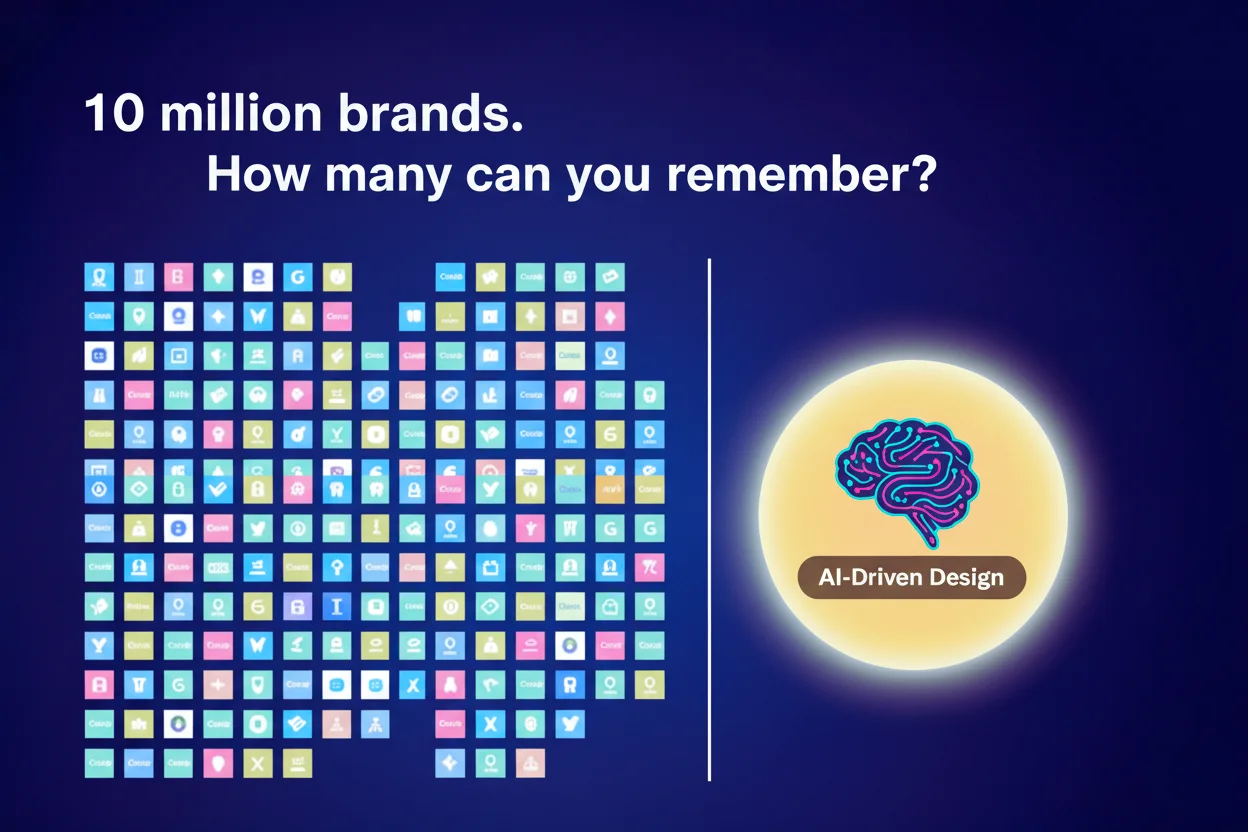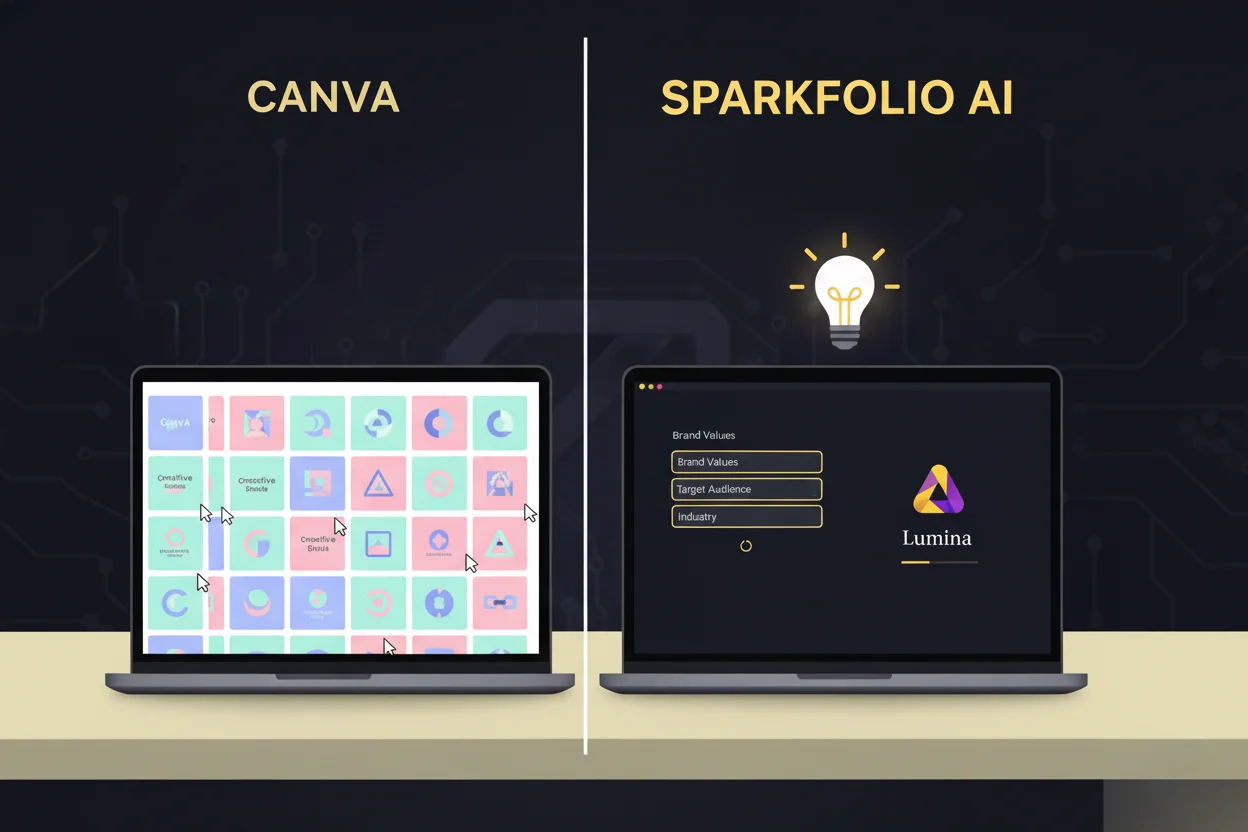Canva is used by 10M+ brands. Here's why most look identical—and how AI brand generation stands apart.
Introduction
Every founder wants their startup to look professional fast. That's why platforms like Canva exploded—making design easy, cheap, and accessible to anyone with a mouse.
But here's the uncomfortable truth: if your brand looks like everyone else's, you're already invisible.

While DIY design tools like Canva give instant gratification, they also create an epidemic of visual sameness. The same fonts, gradients, and color templates appear across thousands of brands, killing originality and recognition.
Meanwhile, AI-powered branding tools like SparkFolio are rewriting the rules — generating unique, data-driven designs tailored to your market and audience.
This post breaks down why the "Canva convenience trap" might be costing your startup customers — and how switching to AI brand generation helps you stand out, not blend in.
The Canva Phenomenon: Fast, Familiar, and Fatally Generic
Canva has become the go-to solution for bootstrapped founders and small teams. It's quick, affordable, and incredibly user-friendly. Over 10 million brands use it to design everything from logos to Instagram posts.
But here's the catch: the very thing that makes Canva popular — its ease and accessibility — also makes it dangerous for startups trying to build a serious brand.
Because every Canva user pulls from the same public library of 600,000+ templates, brand identities start to blur together.
You can spot it instantly: the same pastel gradients, identical "modern sans-serif" fonts, and geometric logo shapes that appear across industries.
What began as "democratized design" has quietly become mass-produced mediocrity.
In other words — if you can design it in five minutes, so can everyone else.
The Hidden Cost of DIY Design Tools
1. Template Overuse and Brand Fatigue
Template overuse is Canva's biggest weakness. While templates are great starting points, most founders never customize them enough to create distinction.
The result? Thousands of identical brands that look like variations of the same idea.
- That "minimalist blue logo with a circle"? Overused by 50,000+ companies.
- That "bold gradient with diagonal lines"? Seen in every other SaaS ad.
- That "handwritten cursive headline"? Common in 30% of D2C brand identities.
This sameness erodes differentiation — the lifeblood of branding.
When everything looks the same, consumers can't remember who you are.
A Lucidpress study revealed that inconsistent or generic branding lowers revenue by up to 23% because customers can't recall your company.
Canva doesn't cause this intentionally — but its structure makes it inevitable.
2. Inconsistent Visual Identity Across Channels
DIY design tools make it easy to create visuals fast — but hard to keep them consistent.
Different team members download templates, tweak fonts, swap colors, and upload their own assets. Soon, your brand loses its visual logic.
Your social posts look different from your website. Your sales deck doesn't match your email signature. Your logo color shifts subtly between designs.
These small inconsistencies destroy credibility.
Brand consistency increases revenue by up to 33%, according to Marq's brand impact study. Yet Canva-based teams struggle to maintain alignment without a centralized design system.
AI-powered branding tools like SparkFolio eliminate this chaos by automatically generating coherent design systems — not random graphics.
Every asset, palette, and layout aligns perfectly to your core identity.
3. Speed Over Substance: The Quality Trade-Off
DIY platforms promise speed — but speed often comes at the cost of strategic depth.
Real branding isn't about dragging shapes; it's about psychology. It's color emotion, hierarchy, target audience, and message alignment.
Canva helps you make designs, not brands.
While you might feel productive, what you're actually doing is creating surface-level visuals that lack meaning or memorability.
A startup can have hundreds of Canva posts yet fail to build trust because nothing feels cohesive or intentional.
A professionally designed identity — whether human-made or AI-generated — builds familiarity, emotional consistency, and confidence.
Your customers don't buy your logo. They buy what it represents.
The Psychology of Original Design
Humans process visuals 60,000 times faster than text. When users land on your site, they form an impression in just 0.05 seconds — and 90% of that judgment is based on design.
Generic design triggers generic perception.
If your brand looks identical to competitors, users subconsciously assume your product isn't unique either. That's how DIY design tools quietly kill conversion rates.
Originality signals authority. A unique visual identity tells the brain, this brand is thoughtful, capable, and premium.
That's what AI brand generation offers: psychological precision, not just pixels.
Canva vs AI Brand Generation: The Core Difference
Let's break down what really separates Canva from AI-powered branding systems like SparkFolio.
| Feature | Canva | SparkFolio (AI Brand Generation) |
|---|---|---|
| Approach | Template-based | Data-driven brand generation |
| Design Output | Reused layouts | Unique brand system |
| Customization | Manual tweaks | Automatic alignment to brand psychology |
| Consistency | User-dependent | AI-enforced across all channels |
| Speed | Minutes | Minutes (with strategy built-in) |
| Scalability | Manual updates | Auto-scaling across assets |
| Outcome | Fast visuals | Cohesive identity & conversion boost |
While Canva democratizes design execution, AI brand generators democratize brand intelligence.
The Illusion of Creativity in Templates
Canva gives the illusion of creativity without the foundation of originality.
Its templates guide users toward pre-made visual frameworks. But true creative differentiation comes from strategic constraint, not decorative choice.
When ten brands use the same stock layouts, creativity becomes mimicry.

AI, on the other hand, uses your brand data — audience, tone, values, market category — to create original compositions, color psychology mappings, and logo forms that no one else has.
This is where AI brand generation beats DIY design: it doesn't decorate — it defines.
The Brand Consistency Crisis in Startups
Startups often struggle with fragmented design. Different tools, freelancers, and Canva templates lead to mismatched branding.
Without unified creative logic, startups lose their ability to look credible.
A consistent identity is one of the most powerful business assets. According to McKinsey, companies with cohesive branding outperform competitors by up to 20% in revenue growth.
SparkFolio solves this through automated consistency: once your brand identity is defined, every new visual it generates automatically aligns with your fonts, colors, and tone — across presentations, ads, websites, and social media.
It's like having a 24/7 brand guardian powered by AI.
The Problem of Over-Familiar Design
Consumers have developed "template fatigue."
They've seen the same Canva graphics so many times that they instantly recognize them — and tune out.
In fact, a 2024 Adobe survey found that 73% of users skip ads or posts that look "templated or repetitive."
DIY design tools create comfort, not differentiation. But in a crowded market, comfort kills attention.
Your startup doesn't need to look "good enough." It needs to look memorable.
AI brand generation builds pattern-breaking visuals that attract curiosity and trust.
The Professional Branding Gap
Professional design is expensive because it's strategic. Agencies spend weeks studying your business goals, target personas, and competitors to build a brand system.
AI brand generation replicates that intelligence instantly — at a fraction of the cost.
SparkFolio's AI doesn't use templates. It interprets brand data to generate original color schemes, type hierarchies, logo shapes, and layout logic optimized for your niche.
For example:
- A wellness startup might receive soft, calming hues with balanced whitespace for trust.
- A fintech platform gets bold geometry and deep tones for authority.
- A creator brand gets vibrant, contrasting palettes for personality.
Unlike DIY design, every SparkFolio output is data-backed and emotionally precise.
How Template Overuse Erodes Brand Trust
Consumers can sense when design feels mass-produced. It signals that the brand might cut corners elsewhere too — in service quality, reliability, or professionalism.
When users subconsciously associate your visuals with hundreds of others, they assume you're not the original — you're the copy.
Design isn't decoration; it's trust architecture.
If your design looks generic, users expect a generic experience. And in a competitive digital space, even a 1% dip in perceived credibility can slash conversion rates by double digits.
AI-generated design, powered by branding logic, communicates care, quality, and expertise from the first glance.
How SparkFolio's AI Outperforms Canva
SparkFolio isn't another design tool — it's a brand creation engine. Here's how it redefines visual identity for startups:
1. AI-Driven Brand DNA Analysis
SparkFolio analyzes your audience, product, tone, and goals. It then builds a unique "brand DNA" model that defines your personality, values, and differentiation.
2. Adaptive Color Psychology
Unlike Canva's static palettes, SparkFolio chooses hues based on your industry's emotion map and WCAG contrast compliance — optimizing aesthetics and accessibility.
3. Consistent Brand System
Every logo, font, and visual element is connected under a unified grid system — ensuring consistency across web, app, and print.
4. Automatic Asset Generation
SparkFolio creates thousands of ready-to-use templates, all designed within your unique visual rules. No repetition. No generic layouts.
5. Brand Evolution Intelligence
As your brand grows, SparkFolio learns from your engagement data and evolves your identity automatically — a self-updating design ecosystem.
In short, SparkFolio doesn't just help you design faster — it makes sure you never look like anyone else.
Real-World Comparison: Canva vs SparkFolio in Action
Case Study 1: The SaaS Startup Trap
A SaaS founder built her pitch deck and logo using Canva. Investors liked the product but criticized the "cookie-cutter" design. After switching to SparkFolio, her rebranded visuals increased investor engagement by 44% and improved conversion on her website by 27%.
Case Study 2: The Creator Brand
A content creator used Canva templates for years. Followers described her posts as "pretty but forgettable." After moving to SparkFolio, engagement grew 2.3x within three weeks — because every visual now carried a distinct, personal style.
Case Study 3: The Fintech Firm
A fintech startup realized their Canva visuals looked identical to competitors. SparkFolio rebuilt their brand identity around psychological color triggers for trust and authority. Result: 38% higher click-through rates and a stronger brand perception in investor surveys.
Why DIY Design Feels Cheaper (and Hurts More Long-Term)
DIY design tools save money upfront — but cost far more in lost growth.
Every time your visuals fail to differentiate, you lose potential customers who don't recognize or remember your brand.
Every time your design feels amateurish, you lower perceived value — and lower price tolerance.
Your brand should be an investment multiplier, not a liability.
AI brand generation turns design into a competitive asset — one that grows your value with every visual interaction.
The Future: From Templates to Intelligence
The future of design isn't template-based — it's adaptive and personalized.
AI brand generation represents the next evolution of creative automation. It combines:
- Data science (behavioral insights)
- Design theory (aesthetics and balance)
- Brand psychology (emotion and trust)
Together, these create designs that look good and convert better.
Soon, using static templates will feel as outdated as using stock photography in 2010. Audiences will expect brands that feel custom, alive, and intelligent.
SparkFolio is already there — building brands that think.
Closing Thoughts
Canva made everyone a designer. But it also made every brand look the same.
In the new era of AI design, differentiation is destiny. The startups that win will be those that use technology to amplify originality — not replace it with sameness.
Your brand deserves more than a template. It deserves intelligence, psychology, and purpose behind every pixel.
DIY tools deliver convenience. AI delivers conversion.
And when your competitor still relies on templates, you'll be the brand that looks — and earns — like the original.